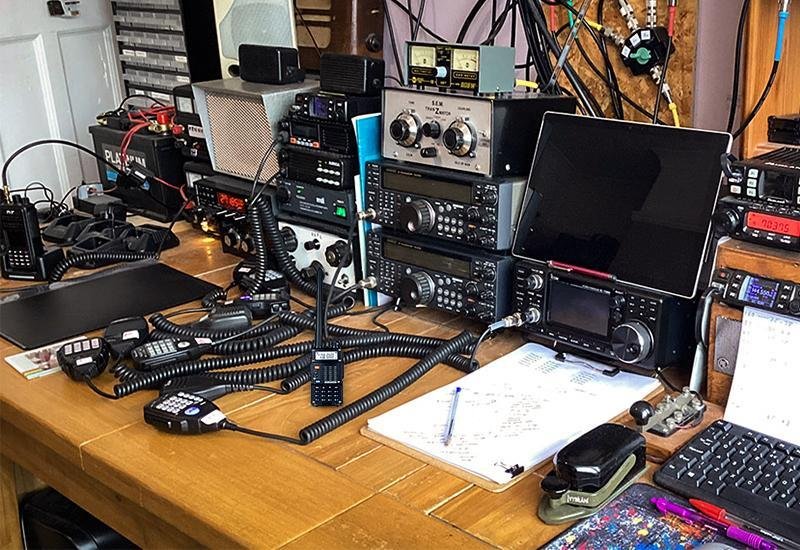Accessories are critical for optimizing ham radio performance, reliability and user experience. From beginners to seasoned operators, having the right tools can make the difference in ensuring clear communication during emergencies, outdoor events or casual use.
Essential accessories, like antennas and power sources, enhance signal strength and system stability, while advanced tools, such as SWR meters and amplifiers, refine performance for challenging conditions. These tools not only improve functionality but also expand operational versatility in various scenarios.
This guide highlights 12 must-have ham radio accessories, divided into Essentials and Advanced Tools, to help you build an effective and reliable ham radio setup tailored to your needs.
How to Choose Right Ham Radio Accessories?
Buying the right ham radio accessories requires balancing your budget, compatibility needs, and operating goals. Follow these practical tips to make smart purchases that suit your specific setup.
Start by determining your budget. For a beginner ham radio setup, affordable options like basic antennas or manual SWR meters are usually sufficient. If you’re an advanced operator, investing in high-performance tools like signal amplifiers or noise filters is worthwhile, as they offer long-term benefits for specialized use cases, such as DXing or operating in noisy environments.
Compatibility is critical when choosing ham radio gear. Always verify that an accessory matches your radio’s frequency range, power output, and impedance. For instance, when selecting an antenna, ensure it supports the specific bands you plan to use (e.g., HF, VHF, UHF). Similarly, check that power supplies or amplifiers are rated for your radio’s voltage and wattage requirements.
Define your operating goals to narrow your options. Beginners may prioritize simple, plug-and-play tools for reliability, like an easy-to-tune antenna or a basic power source. If you often operate in noisy locations, consider accessories like noise-canceling headsets or RF noise filters to boost clarity. For portable or off-grid operations, lightweight solar kits or compact power stations are ideal.
For reliability, buy from trusted brands or retailers like Tigrett Outdoors. These types of reputable companies provide quality products, better warranties, and customer support. By focusing on your budget, compatibility, and specific goals, you’ll ensure that every accessory you buy enhances your ham radio experience while meeting your operational needs.
Essential Accessories for Every Ham Radio Operator
A reliable ham radio setup requires essential accessories that boost range, stability, and performance. Below, we’ll discuss three must-have tools: antennas, power supplies, and SWR meters with actionable tips for maximizing their use.
Antennas: Maximizing Range and Signal Quality
Antennas determine how far and clearly you can communicate. Long-range antennas, like Yagi or beam antennas, provide excellent directional range, while phased array antennas enhance signal clarity for expert users in complex environments.
For DIY enthusiasts, building a DIY ham radio antenna using materials like copper wire or PVC pipes offers an affordable and customizable option. Use online antenna calculators to match your antenna to your desired frequency band.
Power Supplies: Stable and Reliable Power for Your Setup
Ham radios need consistent power for reliable performance. Linear power supplies suit base stations, while solar power kits or portable power stations are perfect for outdoor or off-grid operators.
For off-grid use, pair solar panels with lithium battery packs for efficient, sustainable energy. To avoid interference, opt for pure sine wave inverters, which work seamlessly with sensitive radio equipment.
SWR Meters: Accurate Performance Monitoring
An SWR meter ensures optimal signal transmission by detecting mismatched impedance. Manual SWR meters provide detailed control for experienced users, while automatic models simplify calibration for convenience.
To troubleshoot high SWR readings, check antenna placement, connectors, and feedlines. Adjusting antenna height or using a tuner can also resolve mismatched signals, ensuring peak performance while protecting your equipment.
Advanced Tools for Experienced Operators
Advanced tools, such as signal amplifiers and noise filters, allow experienced ham radio operators to overcome weak signals and interference, ensuring optimal performance in challenging environments. These tools enhance both range and clarity for seamless communication.
Signal Amplifiers: Enhancing Communication
Signal amplifiers are essential for improving communication in weak-signal areas. They boost transmission power, allowing your signal to travel farther and maintain clarity. This makes them ideal for use in remote locations, hilly terrains, or urban areas with obstacles.
Amplifiers provide two key benefits: extended range and improved audio quality. By increasing power output, they help overcome natural or structural barriers, ensuring a strong and clear connection even in difficult conditions.
When choosing a signal amplifier, ensure it matches your radio’s power and frequency specifications. Pairing it with a directional antenna, like a Yagi, can further maximize range and focus. For consistent performance, always monitor power levels and prevent overheating by using models with good cooling systems.
Signal amplifiers are indispensable for maintaining reliable communication in challenging environments.
Noise Filters: Reducing Interference & Boosting Clarity
Noise filters are essential for reducing interference and improving communication clarity on ham radios. They block unwanted noise from power lines, electrical devices, and overlapping frequencies, making them invaluable for operators in noisy or high-RF environments.
Filters with high attenuation levels, such as 40 dB or more, are highly effective at cutting static and boosting signal quality. Adjustable filters are particularly useful, as they allow operators to target specific types of interference based on their location and operating conditions.
When choosing a noise filter, ensure it is compatible with your radio model and frequency range. Using noise filters near industrial areas or power lines significantly enhances signal clarity and ensures smoother communication. They are a simple yet critical accessory for reliable ham radio operation.
Accessories for Convenience and Comfort
Ham radio operators benefit from tools that make communication easier and more enjoyable. Accessories like logbooks, apps, headsets, and microphones not only improve efficiency but also enhance the overall operating experience, especially during long or complex sessions.
Logbooks and Apps: Tracking and Managing Contacts
Logbooks and apps are essential for tracking and managing ham radio contacts efficiently. While traditional paper logbooks are still used, digital logbook apps have become the preferred option for most operators due to their convenience and advanced features.
Digital logbook apps allow you to record contacts with automatic time, date, and frequency entries, minimizing manual work. Some standout features in premium apps include cloud synchronization, integration with radios, and tools for propagation tracking. Free logbook software is great for beginners, offering basic logging and search functions, while premium options provide advanced analytics and compatibility with digital modes like FT8.
Whether you use free or premium software, a reliable logbook helps you manage ham radio contacts, track progress, and even prepare for contests or awards. These tools streamline your operations, making it easier to stay organized during every session.
Headsets and Microphones: Clear & Comfortable Communication
Headsets and microphones improve communication by delivering clear audio while reducing noise and enhancing comfort. They are vital for both casual operators and those managing long or complex radio sessions.
Noise-canceling headsets are especially effective in noisy environments, such as outdoor events or areas with electrical interference. By filtering out background sounds, they ensure that your voice is transmitted clearly. For mobile operators or those working in compact spaces, dual-function microphones with push-to-talk capabilities offer a practical and versatile solution, combining convenience with excellent sound quality.
Lightweight headsets with padded ear cups are ideal for extended use, providing comfort without causing fatigue during long sessions. When operating outdoors or in busy areas, a noise-canceling headset can significantly enhance communication efficiency. Selecting headsets and microphones tailored to your environment ensures clear and comfortable communication every time.
Interactive Comparison: Essentials vs. Advanced Accessories
When building or upgrading your ham radio setup, understanding the difference between essential and advanced accessories is crucial. Your choice will depend on your skill level, communication goals, and budget.
Essential tools are ideal for a beginner ham radio setup. These include items like basic antennas, reliable power supplies, and manual SWR meters. They focus on simplicity and reliability, ensuring you can start communicating quickly without needing extensive technical knowledge. For example, a simple power supply provides stable energy for daily communication, while a well-tuned antenna ensures clear signals over short to medium distances.
Advanced tools cater to experienced operators looking to optimize performance. Advanced tools for ham radios, such as signal amplifiers, digital interfaces, and noise filters, are perfect for long-range communication, working in noisy environments, or experimenting with digital modes like FT8.
For instance, a signal amplifier boosts your reach in remote areas, while a noise filter ensures clarity in locations with high RF interference. These accessories often require more technical understanding but provide precise performance and greater flexibility.
Whether you’re starting with the basics or upgrading your setup with advanced tools, focus on your needs. Beginners should prioritize easy-to-use accessories, while advanced users can explore tools that expand capabilities and enhance communication quality.
Final Words
Ham radio accessories play a critical role in enhancing communication, improving reliability, and making operations more efficient. Whether you’re just starting with essential tools or upgrading to advanced equipment, selecting the right accessories tailored to your needs, budget, and goals ensures optimal performance.
From troubleshooting common issues like SWR calibration or noise interference to choosing accessories for convenience and comfort, this guide provides the insights needed to build a reliable and high-performing ham radio setup. With the right tools and knowledge, you can enjoy clear, consistent, and effective communication in any environment.





